Understanding Our Environment

May 2022 Issue
Understanding Our Environment is the internal newsletter for the Kansas Biological Survey & Center for Ecological Research community. Please email biosurvey@ku.edu regarding any errors or omissions.
Photo: KU scientists led a tour of Breidenthal Biological Reserve on April 30. Photo by Mike Yoder. See more images from this tour on YouTube.
New Field Station Outreach Position
The newly created position of KU Field Station Education Program Coordinator is open; see the full position description on KU’s website. Sheena Parsons, Field Station manager, is search committee chair. This position is pivotal to providing far more outreach at the Field Station and will include the development of a volunteer program. We are conducting a nationwide search; please share this information widely in your networks.
Comings and Goings
Michael MacKenzie, assistant researcher in the Billings Lab, joined us last summer, and his smile is probably is familiar to many of you by now. He graduated from Rockhurst University in Kansas City with a biology degree at in 2020. He assists with the upkeep of the lab, assists the graduate students with their research projects, and occasionally helps with field work.
Please welcome Brooke Bernhardt, who joined the Bever/Schultz Lab just last week as a master’s student in ecology and evolutionary biology (EEB).
Mike Houts, associate researcher, took a new position as GIS analyst for Enel Green Power in January. He says he’s had a great 20 years at the Kansas Biological Survey and the Kansas Applied Remote Sensing program. He is staying on at our research center at a reduced appointment to finish current projects: the Mutt Run dog park pollinator habitat; conservation strategy and priority areas for greater prairie-chickens and sharp-tailed grouse; and development of a spatial data index for Kansas.
Grants and gifts
Dan Reuman, senior scientist and professor of EEB, has been named a recipient of the Humboldt Research Award, a cash prize granted by the Humboldt Foundation in Germany to nominated “internationally leading researchers of all disciplines from abroad in recognition of their academic record to date.” The award comes with an invitation to spend time in Germany and work with others there. Dan plans to go this fall, during his sabbatical, and likely again in the spring. He will visit Uli Brose of the German Center for Integrative Biodiversity Research (known as iDiv) and work on theoretical approaches to the relationship between biodiversity and ecological stability.
Jude Kastens, associate research professor, Kansas Applied Remote Sensing program, is part of the Kansas NSF EPSCoR team that received the $24M award ($20M NSF, $4M State of Kansas) described in a story released by KU News on May 17. He made the map (below), included with the story, of collaborators and research sites and provided the Neodesha flood image used, which he acquired through his connection with Mike D’Attilio of the Kansas Division of Emergency Management. The project’s objective is to develop tools that help communities with limited resources prepare for and recover from disasters. KU researchers will collaborate with 16 other colleges and universities in Kansas, as well as professionals from various fields. The principal investigator is Belinda Sturm, professor of civil, environmental & architectural engineering.
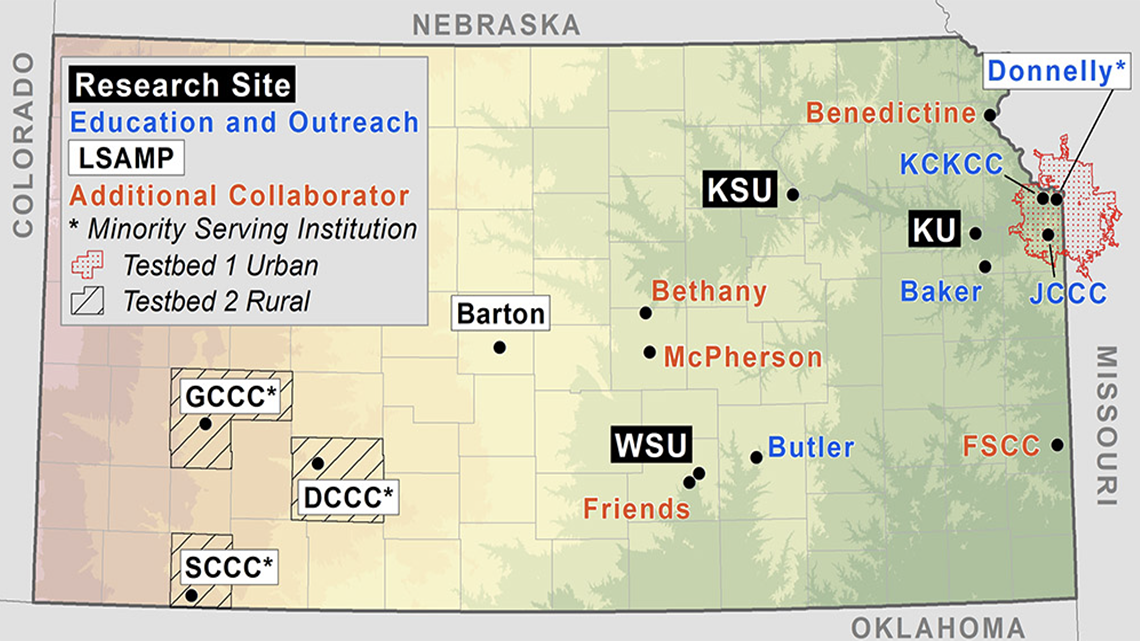
Sara Baer, director of our research center, has secured two gifts totaling $20,000 from TC Energy Foundation of Houston in support of a proposal titled “Teaching on Conservation Lands.” The gifts will provide funding used for the purchase of equipment for outreach and education, including field courses and community outreach programs at the KU Field Station.
New Research Products
Jude Kastens and Chris Bishop of the Kansas Applied Remote Sensing program recently added Ukraine and nearly all of Europe to the GreenReport, which uses Normalized Difference Vegetation Index (NDVI) satellite data to monitor the vegetation health of crop fields and natural vegetation. The maps are updated every eight days during the growing season. The GreenReport illustrates trends for the U.S. lower 48 states and also includes Brazil, Argentina and China. Chris is an assistant researcher.
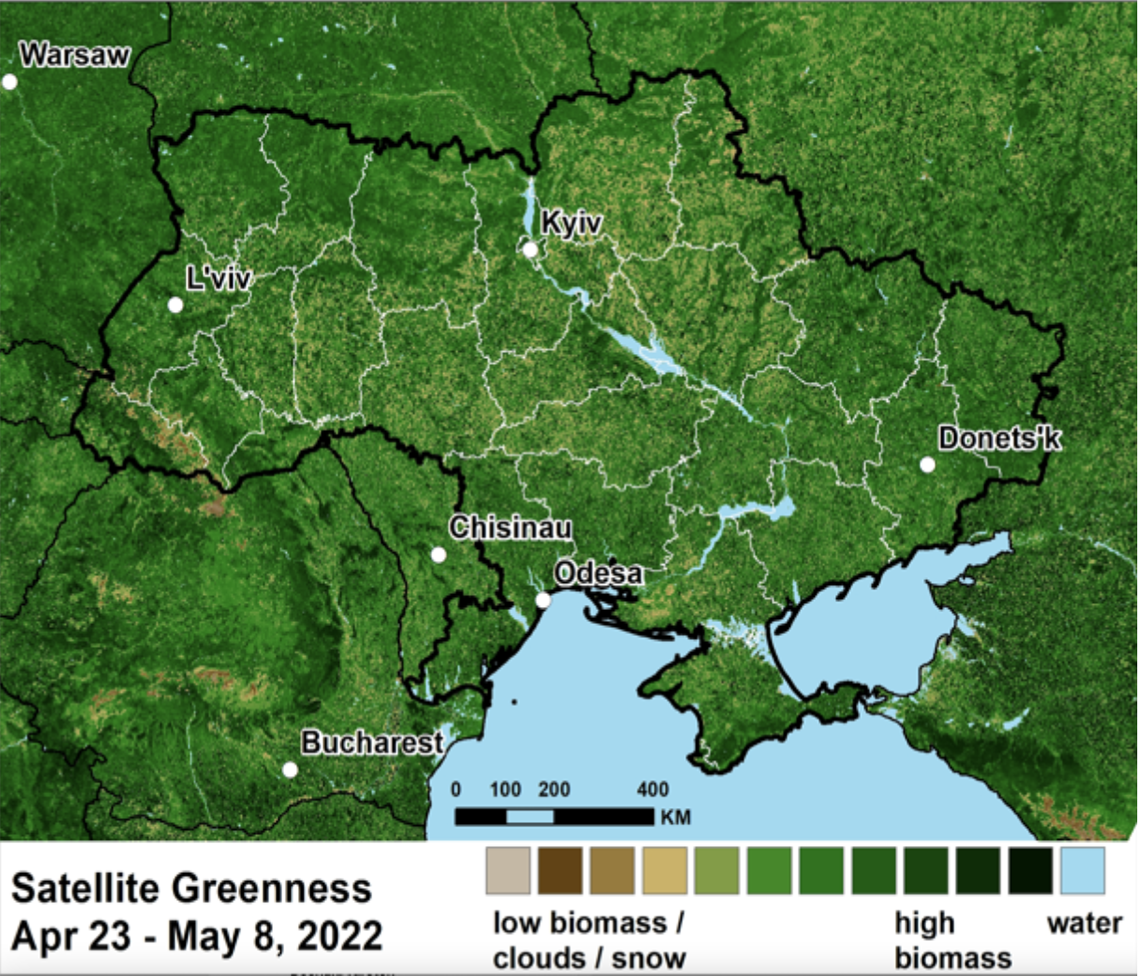
Jennifer Delisle, information manager for the Kansas Natural Heritage Inventory, shares that the KU Field Station recently made available to the wider research community its long-term data on forest demography. The data package is available through the data portal of the Environmental Data Initiative. Abstract: In 1980 researchers at the KU Field Station initiated a long-term experiment monitoring the composition of oak-hickory forest communities to determine how forest species composition varied temporally across distinct habitats that varied in topography, elevation, sun exposure, management history and successional stage. Ten permanent sites were sampled approximately each decade with data collection periods of 1980–1981, 1993–1995, 2002–2003 and 2014–2015. Trees with a minimum diameter at breast height (dbh) of ≥ 7.5 cm were tagged, identified to species and measured. Trees will be measured again in 2025–2026. Researchers involved include Bryan Foster (senior scientist, professor of EEB), Sheena Parsons, Dean Kettle (associate director for research, KU Field Station, retired), Vaughn Salisbury (KU Field Station program manager), Galen Pittman (biologist, retired), and Jeremy Forsythe (graduate student, 2015–2016).
Publications
Eric Duell, postdoctoral researcher in the Bever/Schultz Lab, has had two new papers accepted for publication: “Inoculation with native grassland soil improves native plant species germination in highly disturbed soils,” in press at Grassland Research (co-authors K.R. Hickman and G.W.T. Wilson); and “Inoculation with native soil improves seedling survival and reduces non-native reinvasion in a grassland restoration,” in press at Restoration Ecology (co-authors A. O’Hare and G.W.T. Wilson).
Craig Freeman shares two new papers, both published in the Transactions of the Kansas Academy of Science: “Vascular flora of the Dingus Natural Area, Linn County, Kansas,” co-authored by Caleb Morse, and “New and noteworthy records of vascular plants for Kansas.” Craig is a senior scientist and senior curator at KU’s R.L. McGregor Herbarium; Caleb is collection manager at the herbarium.
Jennifer Moody and Kelly Kindscher have published a paper “The potential for sustainable harvest of common persimmon (Diospyros virginiana L.) fruits at Pea Ridge National Military Park,” in the journal Ethnobotany Research and Applications. They examined the sustainability of persimmon fruit harvest through field surveys of fruit production and the application of the United Plant Savers “At-Risk Assessment Tool,” which was developed by the Kindscher Lab and assesses the risk of overharvesting wild plants. Jennifer is an associate researcher senior. Kelly is a senior scientist and a professor in the KU Environmental Studies Program.
Sheena Parsons and Haiyang Chao, KU professor of aerospace engineering, have published a paper, “Prescribed grass fire evolution mapping and rate of spread measurement using orthorectified thermal imagery from a fixed-wing UAS,” in the International Journal of Remote Sensing. The lead author is Saket Gowravaram, doctoral student in aerospace engineering, for whom the paper was a dissertation chapter. The paper stems from a fire flight at the KU Field Station’s Anderson County Prairie Preserve, and Saket has presented at Friday Ecology Seminars during the paper's development. He is a previous recipient of our research center’s Baldwin Woods Conservation Award for student research. Other co-authors of the paper were Harold Flanagan and Pengzhi Tian (both now KU graduates from aerospace engineering), Tiebiao Zhao of the University of California Merced, Xiaolin Hu of Georgia State University, and Ming Xin of the University of Missouri.
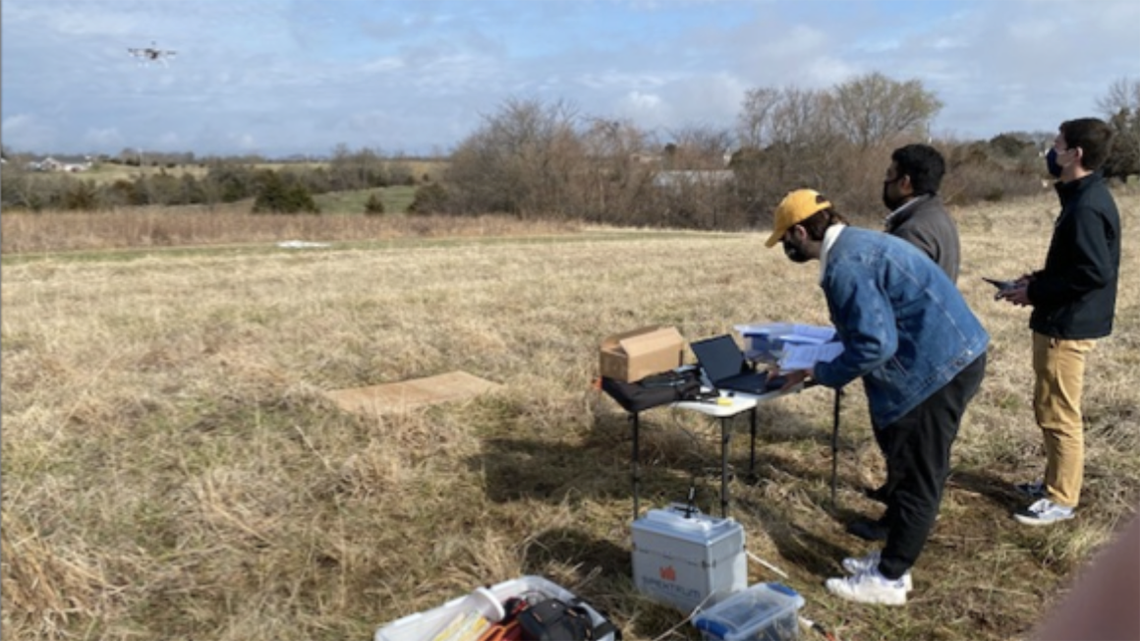
Christopher Rogers, associate research professor,has published four new papers, including “Review of the Limnadiidae (Crustacea: Branchiopoda: Spinicaudata) of southern Africa” in the Journal of Crustacean Biology, with co-author Elizabeth Meyer-Milne of the Centre for Environmental Management, University of the Free State, South Africa. This is the fifth in a series of papers revising and describing the biodiversity of southern African large branchiopods. It reviews the limnadiid clam shrimp and describes three new species in two genera.
Awards
Sharon Billings received the 2022 Byron A. Alexander Outstanding Graduate Mentor Award presented by the KU College of Graduate Affairs. Sharon is a senior scientist and Dean’s Professor of EEB. Recipients of the award are nominated by graduate students in the College of Liberal Arts & Sciences and are faculty and academic staff who “provide outstanding mentorship to master's and doctoral students. They inspire their students through their own teaching, research, and mentoring, foster a collegial learning environment, successfully balance personal support and professional guidance, and prepare their student for careers in the academy and beyond.”
In an April 1 ceremony in Manhattan, Kan., Peggy Schultz was presented with the John K. Strickler Award for 2022 from the Kansas Association for Environmental Education (KACEE).Peggy was recognized for initiating several educational programs for children and teachers in Kansas with funding from Kansas NSF EPSCoR, as well as her creation and leadership of the Ecosystems of Kansas Summer Institute for secondary science teachers, in addition to other prior and ongoing work. Peggy co-leads the Bever/Schultz Lab and is a faculty member in the Environmental Studies Program.
Our research center has provided awards for student research for many years, and in 2022, we were able to provide a record amount of assistance for more students than in any previous year. The KU News story “13 students receive research awards from Kansas Biological Survey & Center for Ecological Research” lists each student’s name, project name and award funding. In the photo below, Adeline Kelly, undergraduate in the Harris Lab and the Sikes Microbial Lab and recipient of the Nancy Hale-Martinko Memorial Award, puts down fuel for burning grass around one of the KU Field Station research ponds as part of the study for which she is receiving support: “The effects of fire on lake phytoplankton community composition in grassland ecosystems.” Ted Harris, assistant research professor, shared this photo.
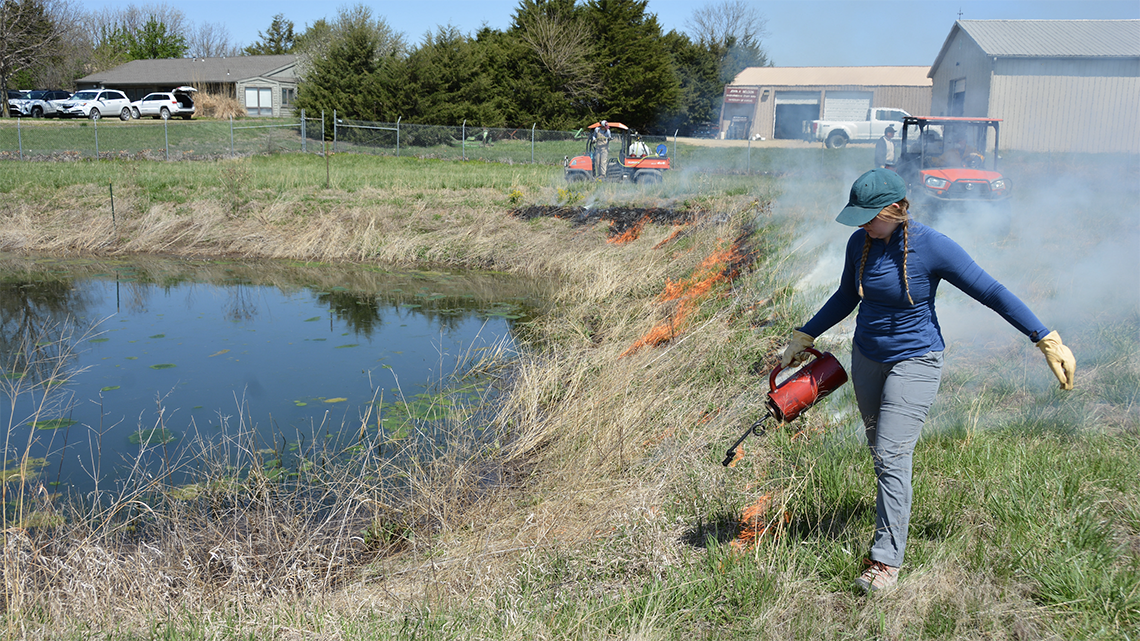
Ligia Souza, doctoral student in the Billings Lab, and Theo Michaels, doctoral student in the Bever/Schultz and Sikes Microbial labs, received awards for their presentations at the lightning talks competition held during the 2022 Kansas NSF EPSCoR Research Symposium.
Carlos Schwindt, undergraduate in the Sikes Microbial Lab, won the Outstanding Presentation Award at the 2022 Online Undergraduate Research Symposium. See his winning presentation, “Understanding the Mask Mycobiome.”
Publicity
Liz Koziol was interviewed for the June article “Restoring Native Prairie Plants? You May Be Missing One Key Ingredient—Fungi” in The Daily Yonder, a digital rural news source produced by the nonprofit Center for Rural Strategies.
Denver magazine 5280 interviewed Kelly Kindscher for a story on the complexities of the harvest of wild oshá plant, “Inside the Debate Over Who Should—and Shouldn’t—Have Access to a Medicinal Plant Called Colorado Cough Root.”
Presentations
Sharon Billings gave a keynote address on her lab’s research at the 8th International Symposium on Physiological Processes in Roots of Woody Plants, held July 10–14 at Penn State University Park Campus in State College, Pa. The following week, at the workshop "Expanding the Critical Zone Research Network" at the Colorado School of Mines, she gave a hands-on workshop on tree sapflux (aboveground) and root quantification (belowground), followed by field work in the Coal Creek watershed in Colorado where she described soil pits, sampled soil, measured water infiltration rates, and photographed roots. The overall workshop focused on broadening participation in Critical Zone Science for the next generation of CZ scholars in Colorado.
In late July, Jude Kastens took part with Ukrainian agricultural economist Antonina Broyaka in a webinar updating war losses in Ukrainian agriculture, “Ukraine Update and Vegetation Signals and Conditions.” The presentation, hosted by AgManager.info, a K-State Research and Extension site, provided a highly detailed report on grain crops and the effect of the war in Ukraine on international agriculture.
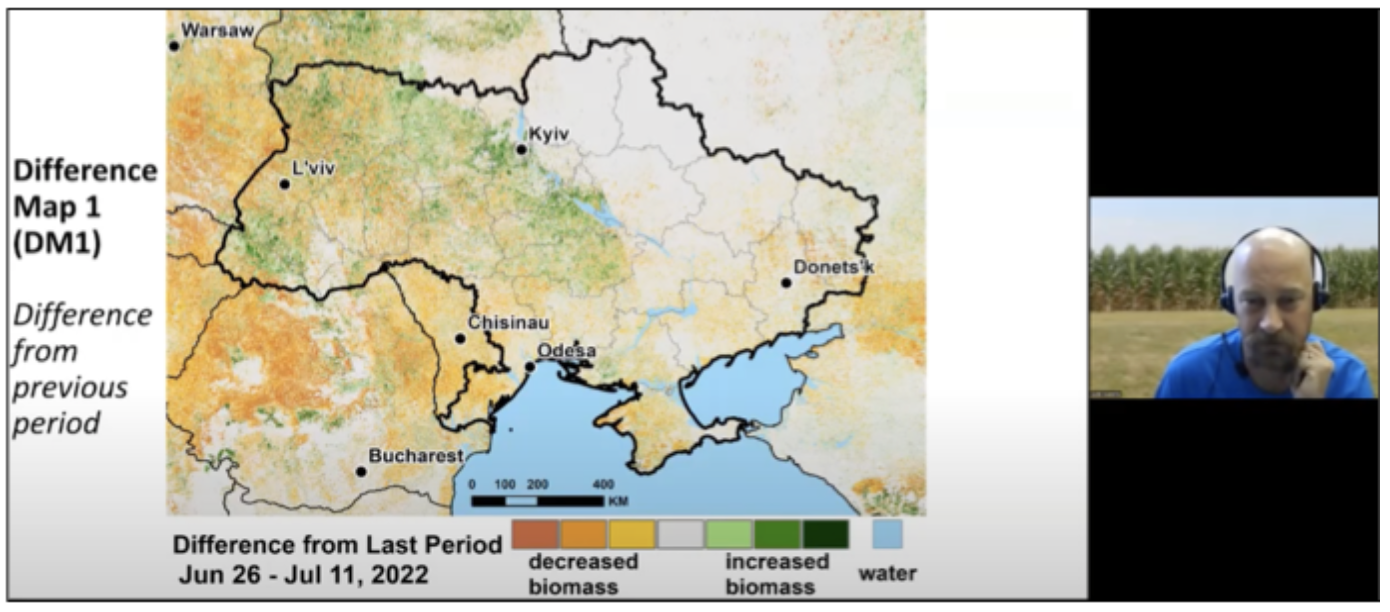
Christopher Rogers is one of four speakers presenting at a KU Medical Center Project ECHO (Extension for Community Healthcare Outcomes) continuing education seminar series, held on Thursdays this month (August), on ticks and tickborne diseases in Kansas. Project ECHO was created at the University of New Mexico nearly 20 years ago to create a knowledge-sharing network that makes health expertise more widely available. KU Med is the first Kansas partner to collaborate with Project ECHO. Health professionals and veterinarians attending the seminar were eligible to receive continuing education credits from the Registry of Approved Continuing Education.
Dissertations
Lígia Souza successfully defended her doctoral dissertation, “Quantifying the depth effects of environmental changes on soil structure and organic matter decay across scales in the Anthropocene,” on Aug. 22. Her advisor is Sharon Billings.
Outreach
At the Aug. 16 City Commission meeting, Lawrence, Kansas, Mayor Courtney Shipley proclaimed September 2022 "The Month of the Monarch" in honor of the 30th anniversary of Monarch Watch, which will hold a variety of events in September.
During the first week of August, a group of middle schoolers from Kansas City, Mo., visited the Field Station as part of Green Works KC's ECO Careers Camp. They met with Wendy Holman, and with Ted Harris and members of his lab, to learn about lakes.
Your Photos
The Harris lab installed a new water quality monitoring buoy on Clinton lake, which will provide data that helps the City of Lawrence better combat taste-and-odor issues in drinking water. Ted Harris took this one of Javier Morales (left), researcher, with undergrads Luke Ungerer (right) and Adeline Kelly.
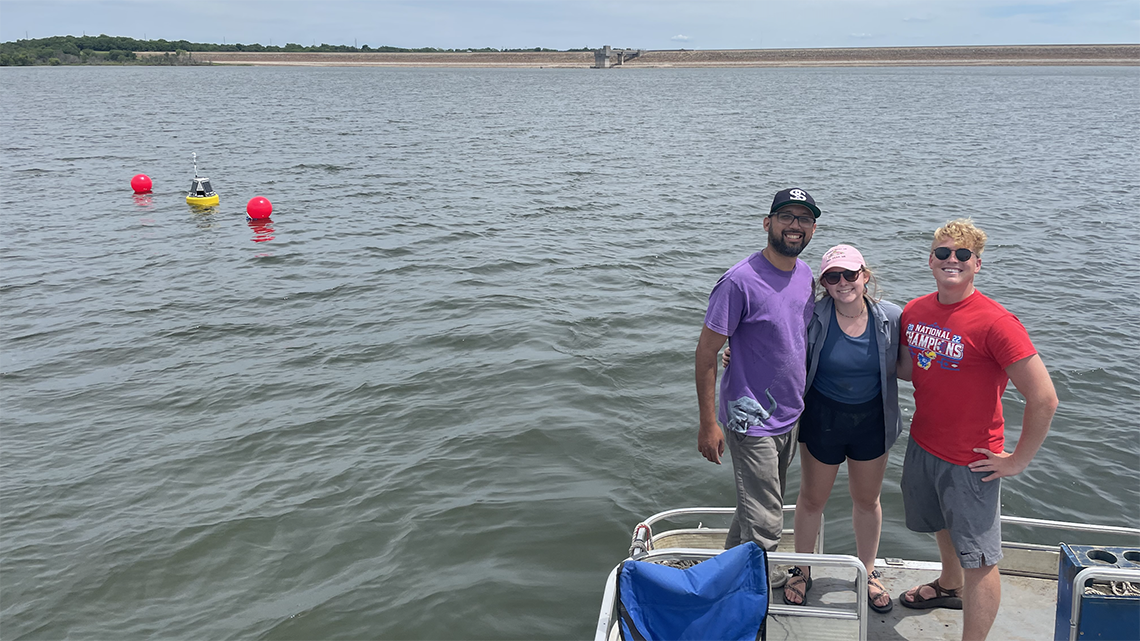
Your Stories
Jennifer Delisle, data manager for the Kansas Natural Heritage Inventory, shares this story that exemplifies the connectedness and long-term commitment of people working to care for native landscapes in the state:
In 2001, Gary Weisenberger of the Kansas Dept. of Transportation visited an Anderson County property to collect seeds for a KDOT roadside restoration. While he was there, he counted more than 100 flowering and vegetative stems of Mead’s Milkweed (Asclepias meadii), a fairly good-sized population for a small remnant prairie, and gave the information to the Kansas Biological Survey. The location was mapped in the database of the Kansas Natural Heritage Inventory, which is housed at our research center and is the state’s sole repository for data about locations of this federally protected milkweed. We regularly use the Inventory to review projects for potential impacts to this rare prairie plant and to work with landowners to preserve the high-quality prairie habitat essential to its survival. No one from the Survey visited the property in 2001, but Kelly Kindscher, community ecologist with the Heritage Inventory, knew Gary.
Fast forward to September 2021. That’s when the landowners met Dena Podrebarac of Monarch Watch at the Baker Wetlands and spoke with her about their 10-acre native prairie. Dena suggested they talk with Kelly about care of the property, and they emailed Kelly and described how KDOT had collected seeds in 2001 and identified the population of Mead’s in the process. Kelly followed up and visited the prairie in this past spring.